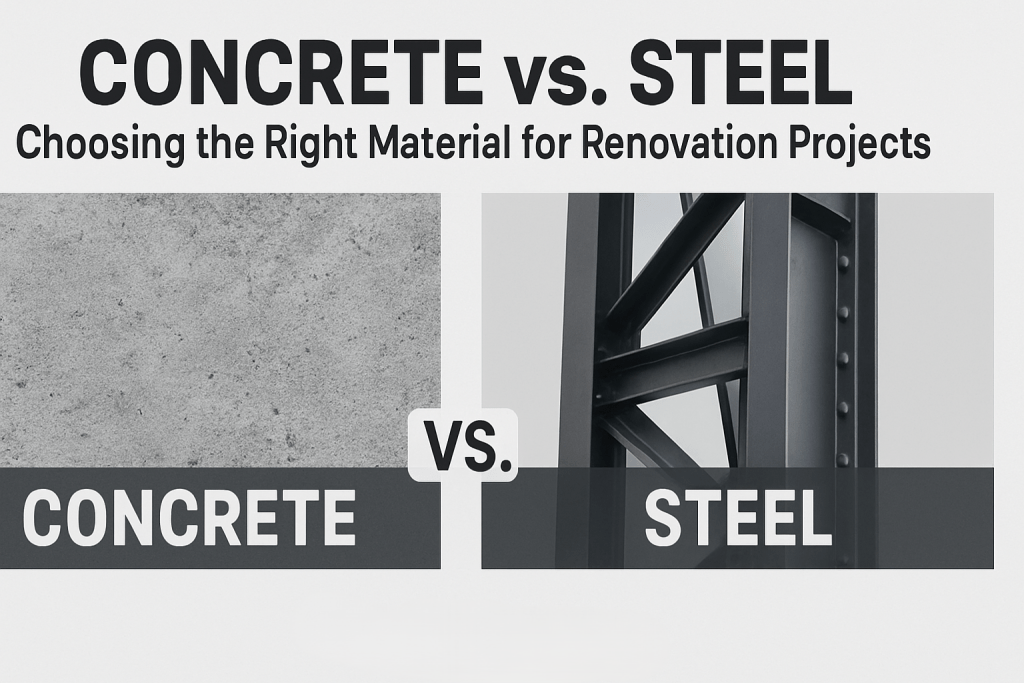
Choosing the right material is one of the most important decisions in any renovation project. Whether you are upgrading a residential home, modernizing a commercial property, or reinforcing an industrial structure, the materials you select will directly impact the safety, durability, cost, and overall success of your renovation. Among the many options available, concrete and steel remain two of the most widely used construction materials. Both have distinct advantages and limitations, and understanding these differences can help property owners, contractors, and engineers make informed decisions that align with their goals.
At Charminar, we specialize in helping clients evaluate the best materials for their unique renovation needs. In this blog, we will explore the benefits and drawbacks of concrete and steel, and how Choosing the right one can make or break your project.
Why Material Selection Matters in Renovation
Choosing materials in renovation projects isn’t just about cost; it’s about long-term performance, sustainability, and design flexibility. The right choice determines how well your structure adapts to new functions, withstands environmental stress, and retains value over time. When comparing concrete and steel, factors such as strength, lifespan, maintenance, and adaptability come into play.
Concrete in Renovation Projects
Choosing concrete has been the backbone of construction for centuries, known for its compressive strength and versatility.
Advantages of Concrete:
- Durability: Concrete can last for decades when properly maintained, making it a reliable option for long-term renovations.
- Thermal Mass: It naturally absorbs and stores heat, helping regulate indoor temperatures and improve energy efficiency.
- Cost-Effective: Generally more affordable than steel, particularly for foundations, walls, and flooring.
- Fire Resistance: Concrete does not burn and offers superior protection against fire hazards.
Disadvantages of Concrete:
- Weight: Concrete structures are heavy, which can limit flexibility in renovation projects.
- Cracking: Without reinforcement, it is prone to cracks over time due to shrinkage or shifting.
- Longer Construction Time: Setting and curing concrete can slow down renovation schedules compared to steel.
Concrete is an excellent choice for projects where stability, fire resistance, and long-term resilience are priorities. However, it requires proper reinforcement and maintenance to ensure maximum performance.
Steel in Renovation Projects
Choosing steel is the preferred material for modern, high-rise, and large-scale renovations, thanks to its strength-to-weight ratio and flexibility.
Advantages of Steel:
- High Strength with Less Weight: Steel structures can support heavy loads without adding excessive weight, making them ideal for complex renovations.
- Speed of Construction: Prefabricated steel components allow for faster installation, reducing project timelines.
- Design Flexibility: Steel can be molded into creative architectural forms, offering greater design possibilities.
- Recyclability: Steel is one of the most sustainable materials, as it can be recycled repeatedly without losing quality.
Disadvantages of Steel:
- Cost: Initial costs are usually higher compared to concrete.
- Corrosion Risk: Without proper treatment, steel is susceptible to rust in humid or coastal environments.
- Thermal Conductivity: Steel conducts heat, which can lead to higher energy costs if not insulated properly.
Steel is an excellent choice for projects requiring adaptability, speed, and innovative design. However, it demands proper coatings and insulation to maximize performance.
Cost Comparison: Concrete vs. Steel
When Choosing between concrete and steel, cost plays a major role. Concrete is often more budget-friendly upfront, especially for structural foundations and walls. Steel, while more expensive initially, can reduce labor and construction time, leading to long-term savings in certain projects. A thorough cost analysis should consider not only material expenses but also maintenance, durability, and lifecycle value.
Environmental Considerations
Choosing sustainability is becoming a top priority in renovation projects. Concrete has a high carbon footprint due to cement production, but innovations such as recycled aggregates are improving its eco-friendliness. Steel, on the other hand, is highly recyclable and often considered a greener option when used responsibly. Choosing the more sustainable material may depend on your project’s scale, location, and environmental goals.
Making the Right Choice
Choosing between concrete and steel ultimately depends on project-specific factors:
- Budget – Do you need a cost-effective solution, or can you invest more upfront?
- Timeline – Is speed of construction a priority?
- Design Goals – Do you want flexible, modern aesthetics or traditional stability?
- Location – Are you building in a humid or earthquake-prone area?
- Sustainability – Do you want the greener option for long-term impact?
At Charminar, our experts assess these factors to recommend the best material tailored to your renovation vision.
Conclusion
Choosing the right material between concrete and steel is more than just a technical decision—it’s about ensuring your renovation project’s success, safety, and value for years to come. Concrete offers durability and cost-effectiveness, while steel provides flexibility and speed. By weighing the advantages, disadvantages, and environmental factors, you can select the material that best aligns with your renovation goals.
At Charminar, we guide homeowners, businesses, and developers through every step of the renovation journey. Whether you lean towards concrete’s timeless reliability or steel’s modern strength, our team ensures that your project is built on the foundation of quality and trust.
Ready to Build with Confidence?
Get in touch with Charminar to learn how our project management expertise can streamline your next development.
📧 contact@bluediamondfm.com
📞 +971 56 705 4223
🌐 https://charminardubai.com/
Frequently Asked Questions (FAQ)
Which material is stronger for renovation projects, concrete or steel?
Both materials are strong, but in different ways. Concrete is excellent in compression, making it ideal for foundations and walls, while steel offers superior tensile strength and flexibility, making it better for large spans and modern designs.
Is steel always more expensive than concrete?
Steel generally has higher upfront costs compared to concrete. However, it can reduce labor and project timelines, which may offset the initial expense in large or complex renovation projects.
Which material requires less maintenance?
Concrete requires periodic inspections for cracks and reinforcement issues, while steel needs protection against corrosion and rust. With proper care, both materials can last for decades.
Which material is more eco-friendly?
Steel is highly recyclable, making it one of the most sustainable options. Concrete has a higher carbon footprint due to cement production, but innovations like recycled aggregates and green concrete are improving its sustainability.
Can I use both concrete and steel in the same renovation project?
Yes. In fact, many renovation projects use a combination of both materials. Concrete is often used for foundations and flooring, while steel is used for structural framing and design flexibility.
What should I consider before Choosing between concrete and steel?
Key considerations include your budget, project timeline, design goals, local climate, and sustainability objectives. Consulting experts like Charminar ensures you make the best choice for your specific renovation project.







